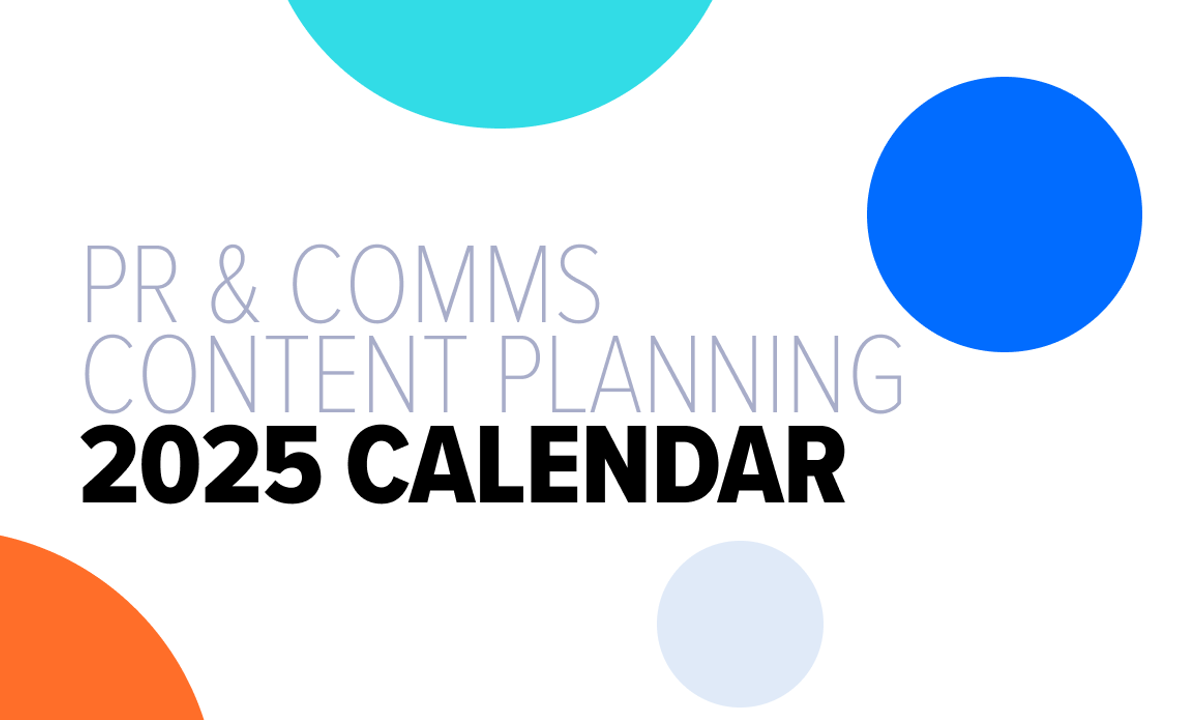
Katie shared the pitch on X, and received hundreds of responses from horrified journalists in her network. The pitch was not only shocking, ill-considered, and insensitive, but signalled a wider issue within the PR industry: A deep chasm in understanding of how to write a pitch and how to make a story truly newsworthy.
Journalists are inundated by hundreds of pitches weekly, and cutting through the noise has become the modus operandi (MO) of many PR professionals. But, from pitch bombing to AI-generated PR, the “coverage-by-any-means” mentality has unfortunately run rife. The pitch Katie Deighton received was an example of just that…

The desperation for coverage has led some PR pros astray in their media pitching. This guide serves as a wake-up call and roadmap for effective media relations – providing insights from seasoned journalists, successful pitch examples, and a framework for crafting outreach that genuinely resonates.
What Is a Media Pitch?
A media pitch is typically an email that a PR professional sends to a journalist or reporter in hopes of gaining coverage in a publication. PR pros usually pitch stories which relate to their brand or client, in order to:
Earn links – which pass traffic and SEO value to their site
Boost awareness through a brand mention
PR pitches can take other forms, such as telephone calls, mail, in-person conversations, or direct messages via social media. That said, according to data from our State of the Media report, journalists overwhelmingly prefer to be pitched via email – 90-95% of our two thousand respondents in North America and Europe selected email as their top channel, followed by phone call (2%), and social media (1%).
Why Is It Important to Get Your Media Pitch Right?
When done right, pitching the media can become a seriously lucrative business. Media coverage not only leads to new links and increased traffic, it also has the power to shift the perception of your brand entirely, improving its equity and value in the eyes of investors. Clever PR can even result in direct sales. But earning PR coverage is not easy…
According to our survey of over 3,000 journalists, a typical reporter receives up to 50 pitches per week. With overflowing inboxes and the added strain of industry layoffs, journalists are juggling multiple beats while striving to meet ever-increasing goals. All of this is to say that journalists are time poor and pitch rich. The window of opportunity to earn that all important coverage is shrinking, and yet journalists report that pitches are as irrelevant as ever.
Read on to find out how to create an impressive media pitch that journalists will be itching to publish…
How To Write a Media Pitch: 3 Essential Tips
1. Think: Story-First, Brand Later
Journalists aren't interested in your brand unless it's truly groundbreaking. What they crave is a captivating story – one that will resonate with their audience. Sure, your ultimate goal is to secure coverage for your brand, but you need to forget that for a minute. Envision yourself as the journalist’s reader. What topics pique their curiosity? Which stories have they devoured lately? Those attention-grabbing headlines are the perfect launchpad for a great pitch idea. They can give you inspiration when it comes to topics, emotions, and styles of content to create. The key to coverage lies in a journalist’s back catalogue.
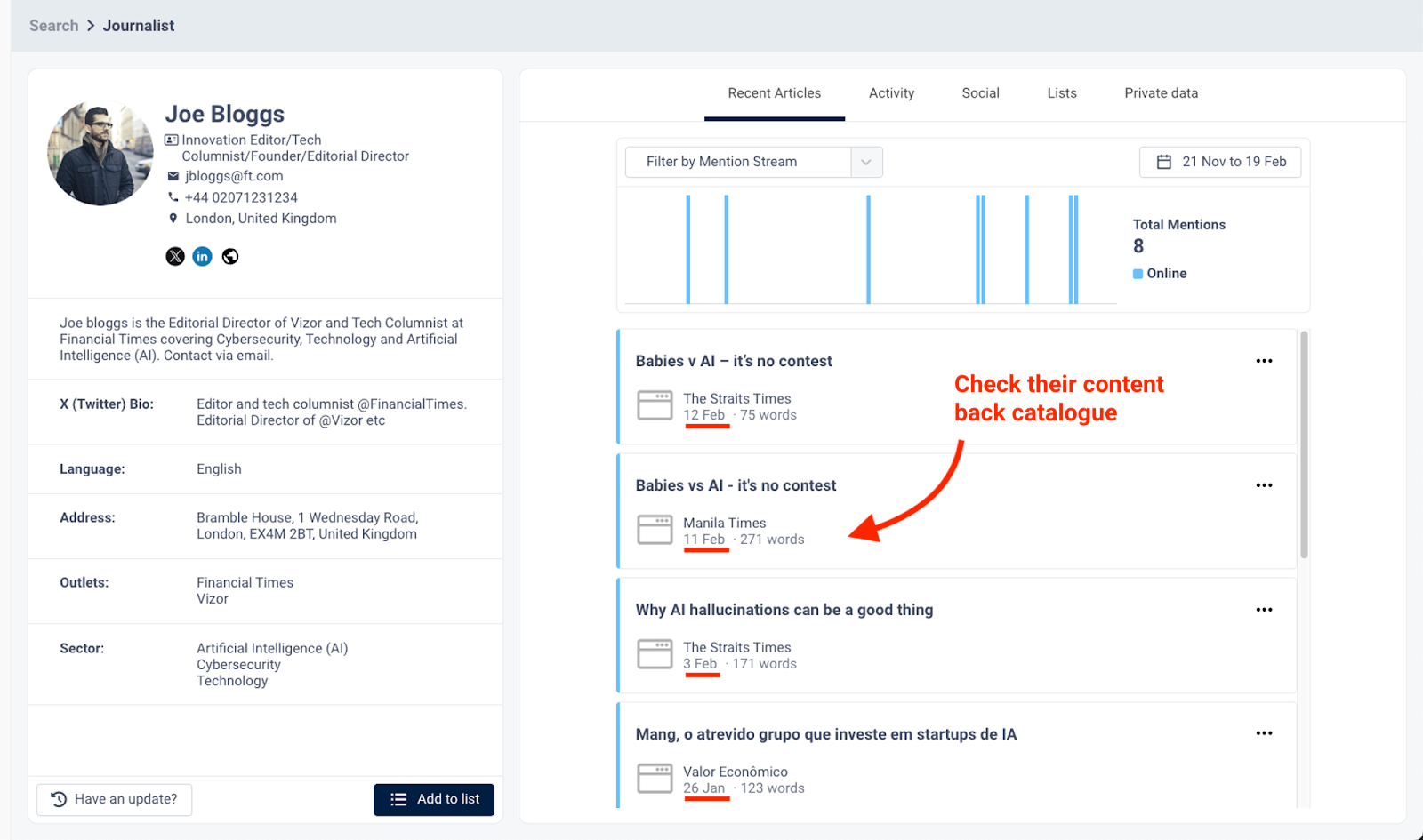
The CisionOne Media Database can help you find the right journalists, and their content, so you can create pitch ideas that hit the mark.
2. Tailor Your Pitch to the Journalist and Their Audience
Sending generic pitches en-masse will get you blocked by journalists. Your media pitch needs to be intentional, with a keen awareness of who is on the receiving end.
Here are some ways you can achieve that:
Follow brand-relevant journalists on social media to get updates on their content, opinions, and beat
Set up alerts and Twitter/X lists to take your research further
Subscribe to their Substacks, newsletters, or Discords – many journalists will be across these platforms, so join them to stay in-the-loop
Mirror the topics, language, formats, and emotionality of the content they produce and share
Assess their best pieces of content, and use them as the basis for your next media pitch idea
Monitor popular journalist request hashtags to find new pitching opportunities
In CisionOne, you can track multiple journalist request hashtags and mentions all in one dashboard, to keep an eye on your top pitching opportunities.
3. Make Your Subject Line and Email Snappy
Journalists need you to get to the point – and fast. Don’t waste time on a lengthy brand intro – keep things detail-lite.
If you have added extras to supply in the form of sources and data, try teasing that information. If you’re pitching subject matter experts [SMEs], for instance, let a journalist know which topics SMEs are available to talk on, but don’t feel the need to paste their quotes verbatim – unless you feel it’s essential to the story. This gives journalists the opportunity to follow up on the aspects of your pitch that they deem most interesting.
When it comes to subject lines, the consensus is also to keep them snappy. Digital Third Coast analyzed 450 PR pitch subject lines and found those with the highest open rate were short, newsworthy, keyword-relevant, and context appropriate (e.g. the correct length for journalists reading on mobile vs. desktop).
“A good subject line is concise, specific, and engaging. It should be clear what the pitch is about and why it’s newsworthy. Including keywords that journalists might use when searching for stories is also effective... Overall, the best subject line length across all mediums was an average of 60 characters.”
Jen LeMair, Digital PR Outreach Manager
How to Send Your Media Pitch Strategically
Avoiding mass mailouts is, by now, a no-brainer in PR, but batching your pitch creation by angle, vertical, or niche can be a great way to boost efficiency. This approach allows you to reuse relevant wording/information across related pitches, while maintaining context and flow in your writing. The only caveat is that the number of pitches you include in each batch must be kept to a minimum, to ensure relevance. Here are some other ways you can batch and prioritize your outreach:
By coverage potential: Prioritize those who are most likely to cover your story
By publication: Send to journalists at major publications first, then work your way down to the niche
By geography: Batch your pitch sends based on time zone and location
5 Media Pitch Examples That Made It to Publish
1. The “Short and Sweet” Media Pitch Example
Name: Sujan Patel
Title: Contributing writer
Has written for: Forbes, Inc., and Entrepreneur Magazine
Sujan Patel has received thousands of pitches while working as a contributing writer for publications like Forbes and Entrepreneur. Below he gives an example of one of his favorite pitches, and his reasons for choosing it.
The PR Pitch
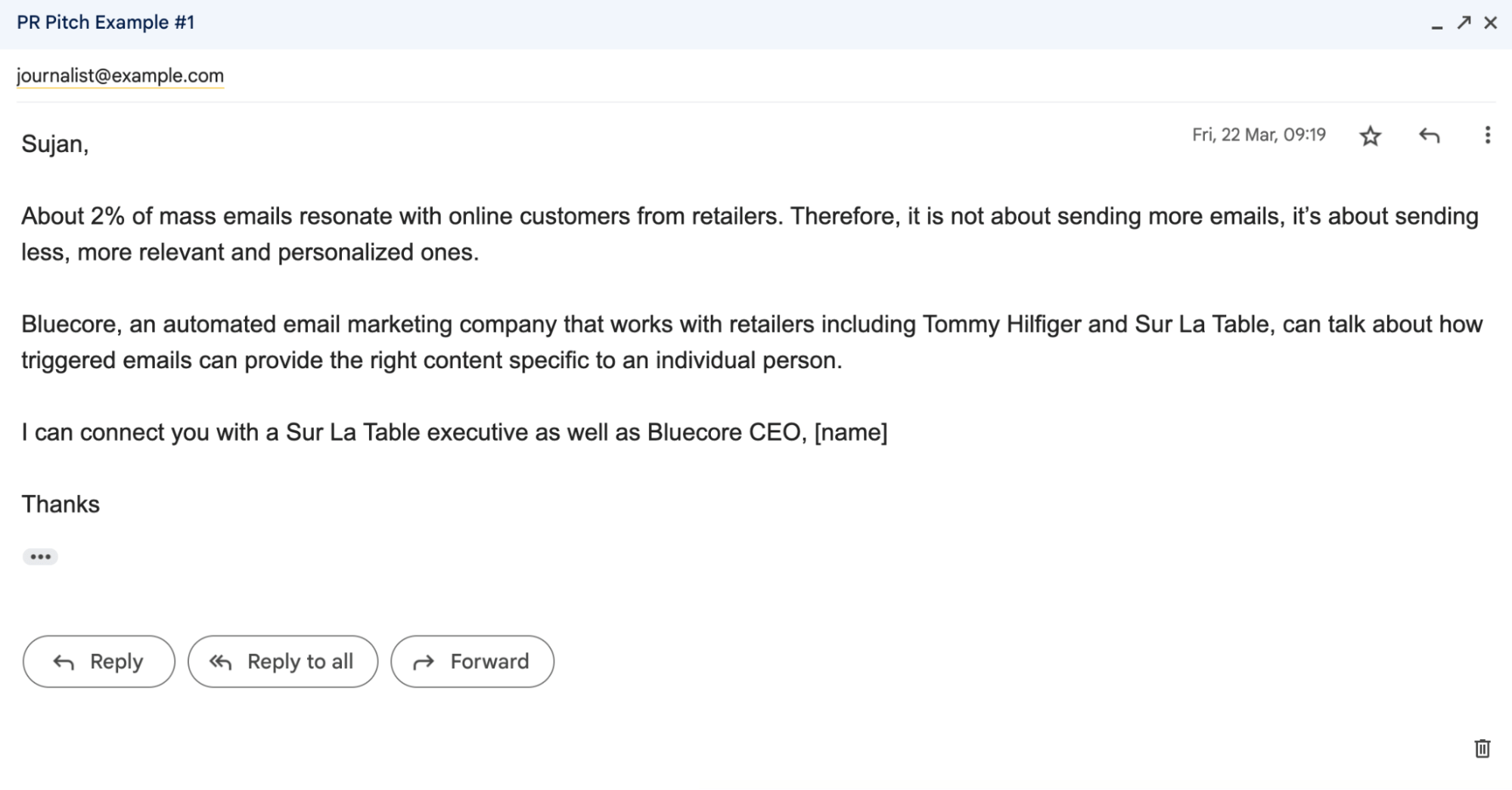
What’s Good About This PR Pitch, According to Sujan?
“Here’s an example of a pitch I was pretty impressed with. It included enough information to pique my interest, but was short and sweet enough to retain my attention. It also included a clear call to action.”
Read more from Sujan on what makes a good PR pitch here.
2. The “Old Story, New Angle” PR Pitch Example
Name: Olivia Morely
Title: Senior advertising reporter
Has written for: AdWeek
Olivia Morely receives so many pitches from PR pros that her automated email response navigates them to a complete guide of her pitching preferences. It is incredibly helpful in revealing what journalists need from a pitch. You can read it here. For an example of her favorite pitch, read on…
The Media Pitch
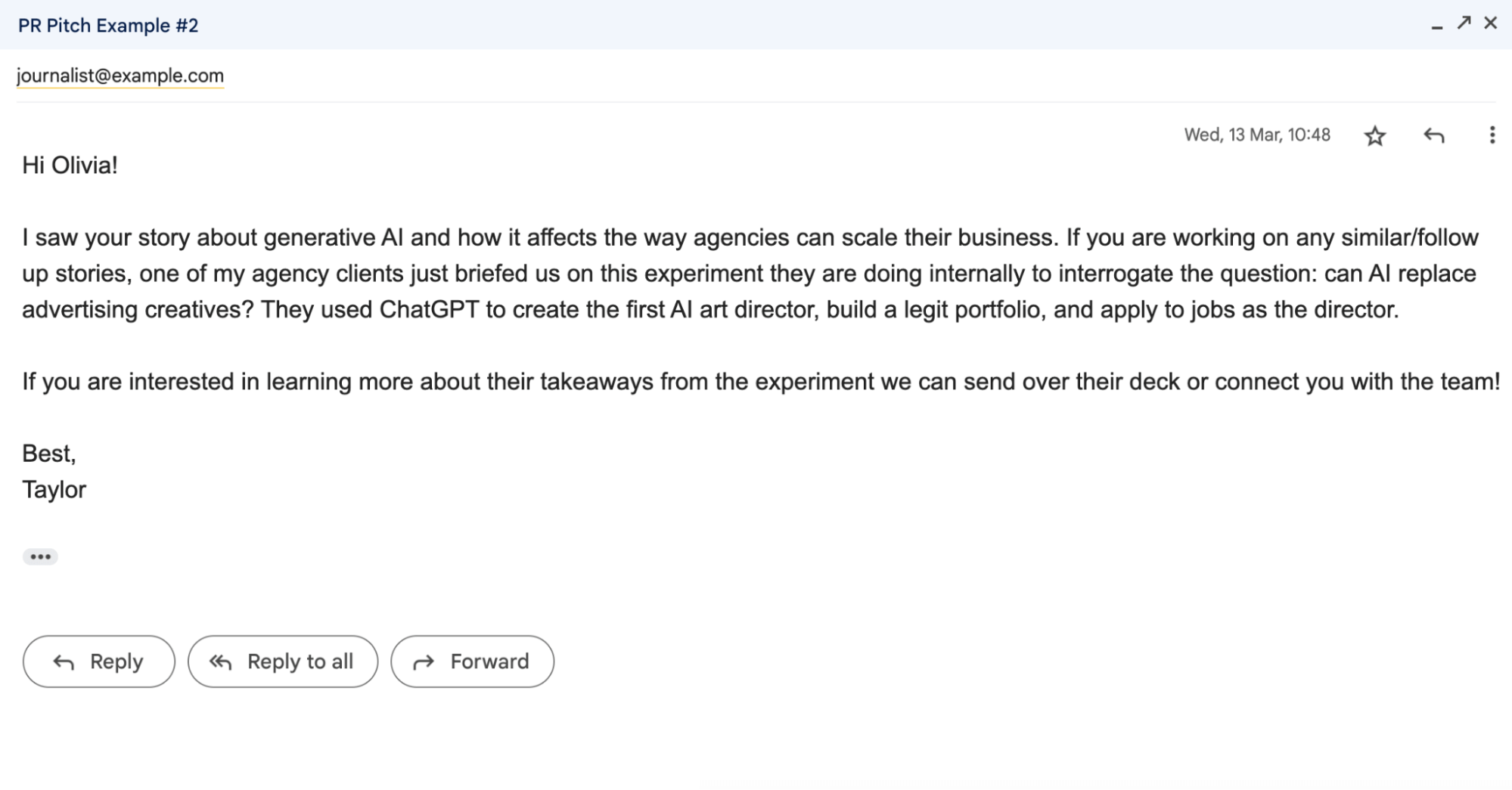
What’s Good About This PR Pitch, According to Olivia?
“Taylor read a recent story I’d done, but pitched me on a totally different angle! This pitch’s length is perfect. One paragraph summarizing the gist of the article made it easy to absorb.”
Read the article that the pitch became here.
3. The “Proved They Did Their Homework” Media Pitch Example
Name: Kendall Bakeer
Title: Contributing Writer
Media outlet: The Hustle
Kendall Bakeer was so fed up with receiving spam-like pitches, that he wrote an open letter to PR professionals telling them exactly what he expects to see from a pitch. Here’s an example of a good pitch in his eyes…
The Successful PR Pitch Example

What’s Good About This PR Pitch, According to Kendall?
“Not only did this person read something I wrote (it’s a pretty sweet article), but he/she also took the time to go into detail about it. This builds a relationship right off the bat, making it more likely that I continue reading and then email back (the rest of this email was a pretty standard pitch). It takes about five minutes to read a post, people. And it all but guaranteed this person a response.”
Read more from Kendall on what makes a good PR pitch here.
4. The “Reactive Research” PR Pitch Example
PR Pro: Kelsey Libert
Brand/Agency: Fractl
When New York City Public Schools banned ChatGPT in late 2022, Kelsey Libert's team at PR agency Fractl saw an opportunity to newsjack the story. In her BuzzSumo article “PR Links and Earned Media CAN Lead To Organic Traffic. Here’s How…“ Kelsey reveals how Fractl quickly surveyed educators and students to understand their thoughts and concerns about this major education policy shift, and pitched it to media outlets covering education, parenting, technology, and politics.
The results were impressive:
Coverage in prominent publications like The Wall Street Journal, Business Insider, USA Today, EdWeek, SF Chronicle, Independent, Yahoo!, TechSpot, Entrepreneur, Futurism, The Guardian, and Silicon Republic
Links from over 300 sites across two campaign executions
By acting fast and offering valuable, data-led perspectives, Fractl positioned their client as a thought leader in the ChatGPT and education policy debate. Here’s the pitch that won them coverage:
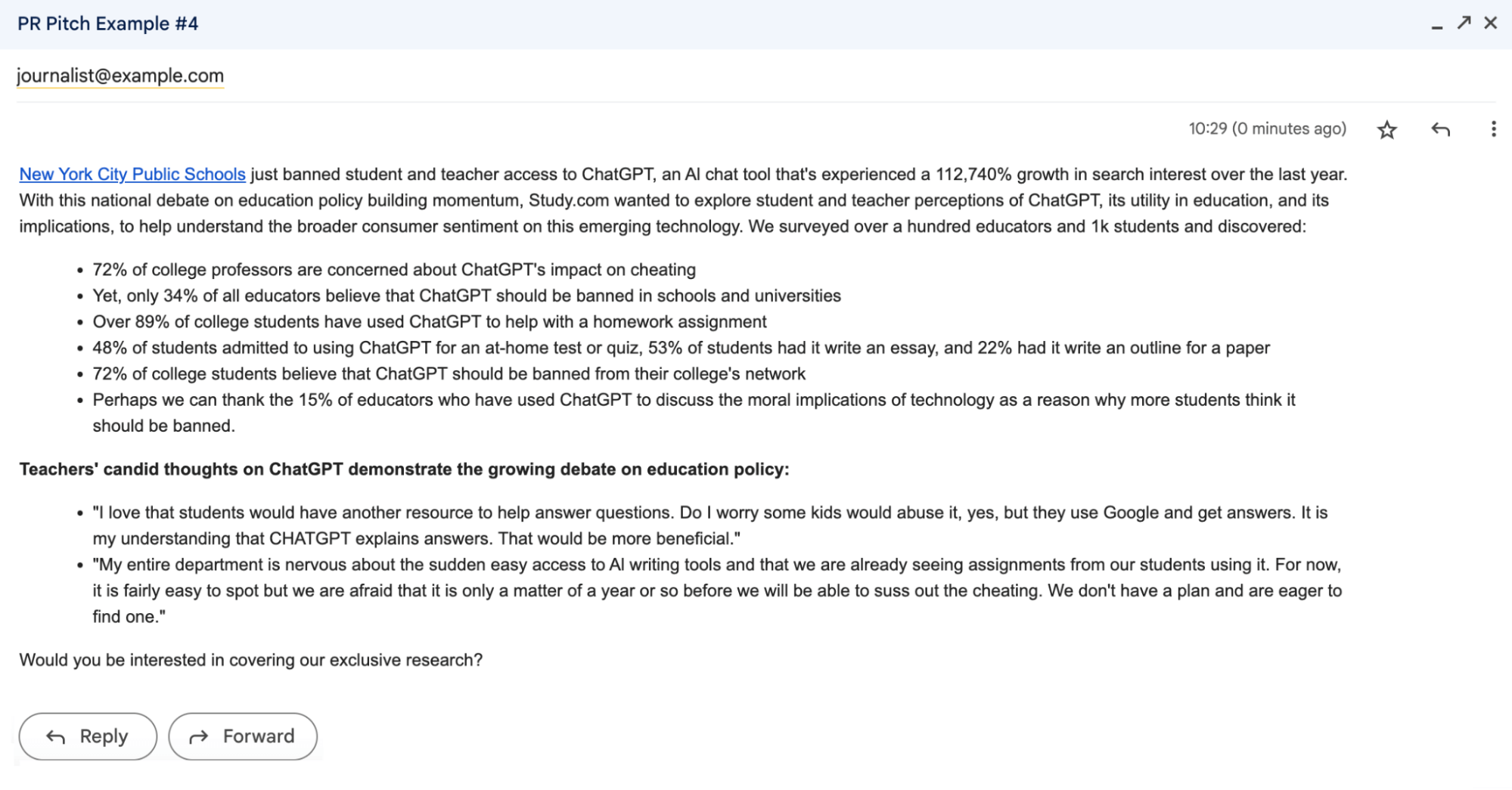
Read more from Kelsey on the results of Fractl's PR pitch via BuzzSumo.
What’s Good About This PR Pitch?
It Taps Into a Trend
The pitch does an excellent job of zeroing in on a hot topic: the national debate around ChatGPT's impact on education policy. By highlighting a timely issue, Fractl ensured the content was relevant and valuable to journalists.
It Includes Solid Data
The pitch doesn't just make claims – it supports the narrative with quantitative research. From 112,740% growth in ChatGPT search interest, to detailed survey results, there's a strong data-driven foundation.
The Campaign Idea Was Strong
The pitch idea and execution were solid from the outset, so the email copy wrote itself. The opener needed only to set out the context of the trend, and the remaining paragraphs to include the research findings and quotes.
It Adds Color with Different Perspectives
Beyond the numbers, the pitch includes candid quotes. This humanizes the story, provides a richer, multi-faceted view of the issue, and gives journalists another angle or article style to work with. If they couldn’t see a place for statistics in their next article, maybe they’d want to use the contributors as part of a human-interest story.
It Leaves Room for Further Exploration
The final question about "exclusive research" is a smart move. It’s a clear CTA that piques the journalist's curiosity and leaves the door open for expanding the story with additional context and analysis.
5. The “Emotional Exclusive” Media Pitch Example
Name: Tom Mazzarelli
Title: Executive producer
Media outlet: The TODAY show
While the following pitch was supplied by an employed correspondent of TODAY, and not a PR pro, it succinctly demonstrates the key tenets of a successful TV pitch – as outlined by the exec producers and editors at NBCU Academy, talking on “The Art of the Pitch”. They are as follows:
The Fundamentals of a Good TV Pitch
Have a clear peg or time frame for when the story should be covered.
Identify the key characters or people who will drive the story and make it compelling.
Ensure the pitch is original, exclusive, and relevant to the specific news outlet/audience.
Preparation and Pitching Style
Do thorough research and reporting before pitching to have a well- developed story.
Decide whether to pitch in writing, in-person, or a combination, based on the news outlet's preferences.
Be persistent, but not overbearing when pitching ideas, and be prepared for some rejections.
Collaborate with colleagues to refine the pitch and get feedback before presenting it.
Budgeting and Logistics
Be up front about any significant budget requirements, as this can impact the decision-making process.
Have a contingency plan if key characters or elements of the pitch change after it has been accepted.
The Successful Media Pitch Example
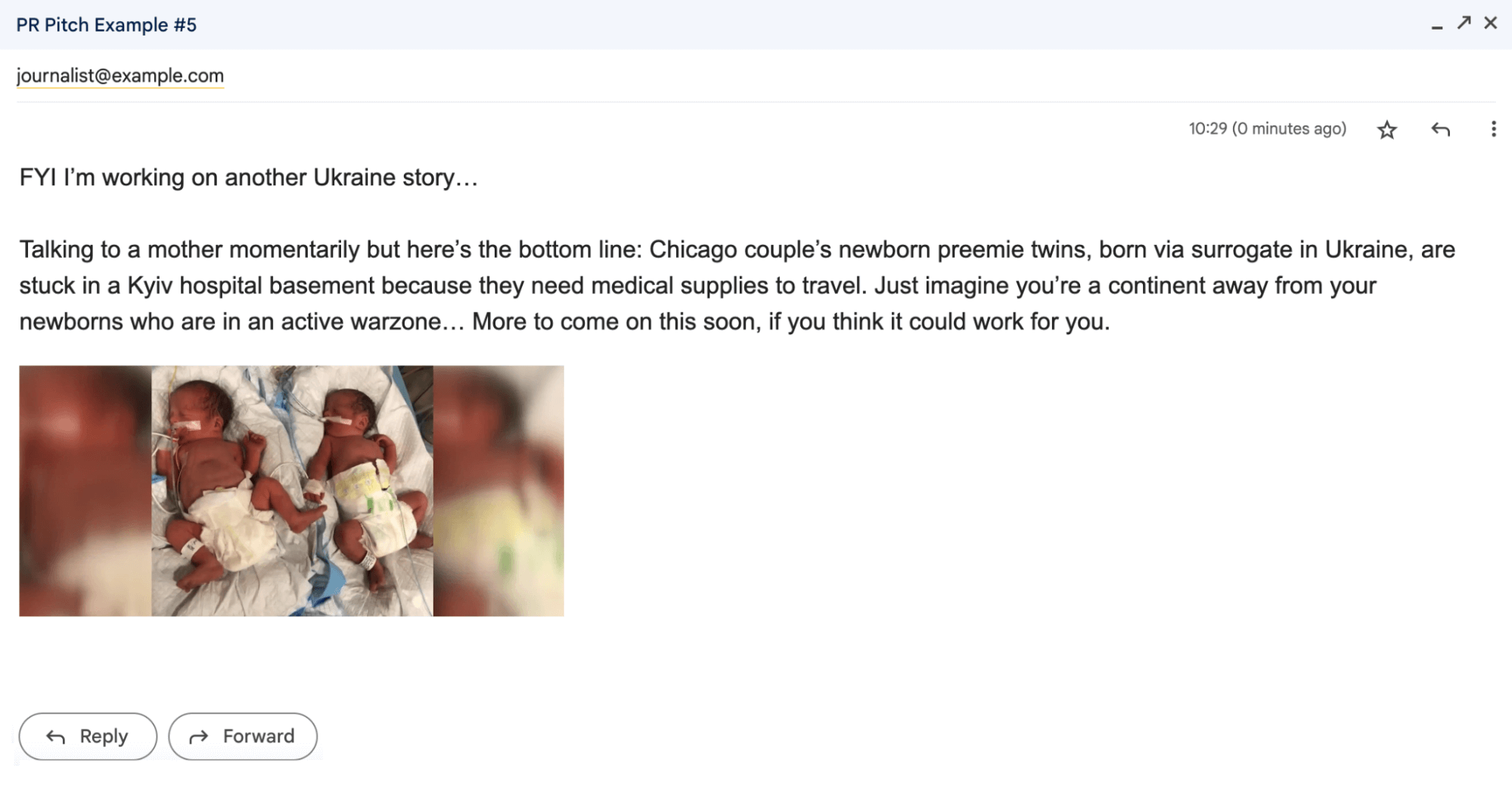
What’s Good About This PR Pitch, According to Exec Producer Tom Mazzarelli?
“It’s funny because this came from an original pitch, which [we] passed on, and then the correspondent came back and said ‘Well I’m also working on this’, so kudos [to him] for sticking with it. We bought it immediately, and part of [the reason] was there was a picture of the premature twins in a NICU (Neonatal Intensive Care) unit in Ukraine. You saw the visual and you could just connect to it. The correspondent was relatively new – this is one of the first pictures we’d gotten from him. We said, ‘Yes, if the parents will talk, we’ll happily take it.’ He ended up getting the parents – who are in the States – on Zoom, and we turned the piece around for the next day. That’s the pace of our show, because [it’s about] what’s going on, but that differs depending on the platform.”
The pitch above was bought by the TODAY show immediately because it had:
A clear and timely news peg: The ability to quickly turn around the story for the next day's broadcast, and the fact that it tied into the wider news story of the war in Ukraine, were key factors in the decision to greenlight this pitch.
Strong key characters: The parents were willing and able to provide a first-hand account of their experience.
An exclusive story: The pitch offered a different type of “war” story, in the form of an untold personal experience.
A strong emotional hook: The pitch fully hit the brief in terms of its audience. The TODAY show viewers are intrigued by human interest stories, and the visuals of the premature twin babies evoke a strong emotional response. The phrasing of the sentence “Just imagine you’re a continent away from your newborns who are in an active warzone…” within the pitch really drives that point home.
Relevance to the audience: Even though the correspondent was new, their pitch demonstrated a keen understanding of what the TODAY show audience would find compelling.
See what the pitch became here.
How To Write the Perfect Media Pitch…
As the real-life examples and quotes throughout this guide prove, the pitches that make it to publish demonstrate an innate understanding of not just what journalists want, but why they want it, and how to package it up for their specific needs.
Balancing audience empathy and the promotion of your client or brand may be challenging, but it's also what generates the type of coverage that creates an impact. Pitch-perfect PR is an ongoing process, but following the tips above will get you 90% of the way there.
For even more nuanced insights into the art of pitching, check out How to Write a PR Pitch That Gets Results: 7 Journalist-Approved Tips.







